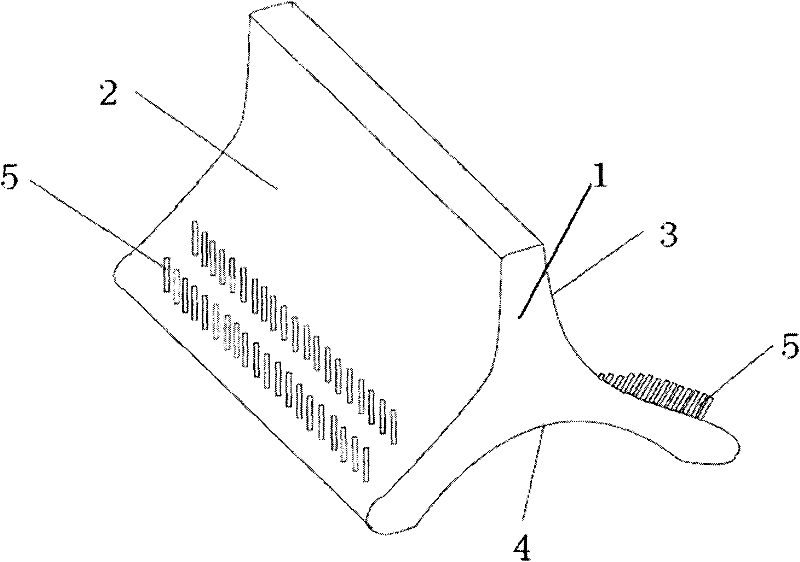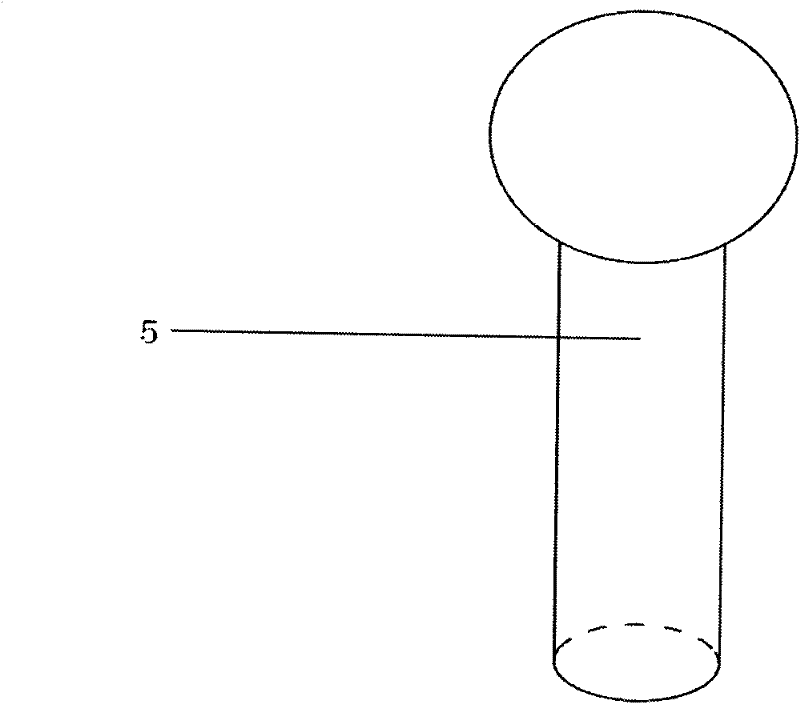Artificial vertebral lamina
A lamina and artificial technology, applied in the field of artificial lamina and devices for fixing the spine, can solve the problems of poor bone conduction and bone induction, unfavorable new bone formation, etc. Effect
- Summary
- Abstract
- Description
- Claims
- Application Information
AI Technical Summary
Problems solved by technology
Method used
Image
Examples
Embodiment 1
[0022] The structural representation of the artificial lamina of this embodiment is shown in figure 2 , as shown in the figure, the artificial lamina is a matrix 1 with a substantially herringbone cross-section and an axial length. The matrix 1 includes three concave curved surfaces 2, 3 and 4, and one of the concave curved surfaces 4 The surface is smooth, and the surface of the concave curved surface 4 is covered with anti-adhesion material, and a plurality of small cylinders 5 are arranged on the surfaces of the other two concave curved surfaces 2 and 3, and the height of the cylinders 5 is 1.8-2mm , preferably 1.83mm, and a cross-sectional radius of 0.05 to 0.1mm, preferably 0.1mm; cylinder 5 is rich in BMP (bone morphogenetic protein, osteoinductive protein) particles, and has an inductive effect on new bone formation; the present embodiment The material of artificial lamina can be polycaprolactone-lactic acid / ethanol copolymer (Chinese patent application 200710300691.7)...
Embodiment 2
[0025] The artificial lamina of this embodiment is a further improvement on the basis of the artificial lamina of Embodiment 1, that is, the top of the cylinder 5 is set as a sphere (see image 3 ), the radius of the sphere is 0.2-0.4 mm, preferably 0.2 mm. Setting the top of the cylinder 5 as a sphere can expand the adhesion and contact area between the artificial lamina and the new bone target cells, which is more conducive to the growth and deposition of new bone, and makes the new bone grow and form quickly.
Embodiment 3
[0027] The artificial lamina of this embodiment is a further improvement on the basis of the artificial lamina of Embodiment 1, and small holes 6 are also arranged between cylinders 5 (such as Figure 4 shown), the radius of the small hole 6 is 0.05-0.08 mm, preferably 0.05 mm, and the small hole 6 is depressed on the concave surface of the base 1 . The setting of the small hole 6 allows new bone cells and other functional cells to deposit here, which facilitates the formation of a relatively dense cell population, facilitates the biological interaction between cells, and promotes the differentiation and growth of new bone cells.
[0028] It has been verified by experiments that the artificial lamina of the present invention is gradually degraded during use, and finally completely degraded and absorbed by the human body when new bone is formed, which has high safety.
PUM
 Login to View More
Login to View More Abstract
Description
Claims
Application Information
 Login to View More
Login to View More - R&D
- Intellectual Property
- Life Sciences
- Materials
- Tech Scout
- Unparalleled Data Quality
- Higher Quality Content
- 60% Fewer Hallucinations
Browse by: Latest US Patents, China's latest patents, Technical Efficacy Thesaurus, Application Domain, Technology Topic, Popular Technical Reports.
© 2025 PatSnap. All rights reserved.Legal|Privacy policy|Modern Slavery Act Transparency Statement|Sitemap|About US| Contact US: help@patsnap.com



